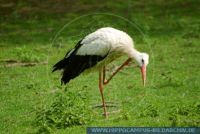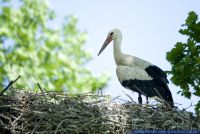Ciconia ciconia
White Stork
Exif Keywords: Natur, Nature, Animals, Tiere, Fauna, Voegel, Vogel, Bird, Fliegen, Fly, Ornithologie, Zoologie, Zoology, Animalia
Exif ImageDescription: Ciconia ciconia,Wei§storch,White Stork
The White Stork (Ciconia ciconia) is a large wading bird in the stork family Ciconiidae, breeding in the warmer parts of Europe (north to Estonia), northwest Africa, and southwest Asia (east to southern Kazakhstan). It is a strong migrant, wintering mainly in tropical Africa, down to the south of South Africa, and also in the Indian Subcontinent. It is a huge bird, 100-125 cm (40-50 in.) tall, with a 155-200 cm (61-79 in) wingspan and a weight of 2.3-4.5 kg (5-10 lbs). It is completely white except for the black wing flight feathers, and its red bill and legs. It walks slowly and steadily on the ground. Like all storks, it flies with its neck outstretched. ...The White Stork is one of the species to which the Agreement on the Conservation of African-Eurasian Migratory Waterbirds (AEWA) applies.White Storks rely on movement between thermals of hot air for sustained long distance flight. The birds take great advantage of thermals during annual migrations between Europe and southern Africa. Normally, this route would take them over the Mediterranean, but since thermals only form over land, storks take a detour. Eastern storks travel over Suez, while hundreds of western ones fly through the straits of Gibraltar and the Bosphorus. That way, they can get help from the thermals for almost the entire trip and save enormous amounts of energy in the process[3] . These storks breed in open farmland areas with access to marshy wetlands. It builds a stick nest in trees, on buildings, or special platforms. Because it is viewed as bird of good luck, it is not persecuted, and it often nests close to human habitation. In southern Europe, storks' nests can often be seen on churches and other buildings. It often forms small colonies. Like most of its relatives, it feeds mainly on frogs and large insects, but also young birds, lizards and rodents. It is almost silent except for the noisy mutual bill-clattering when adults meet at the nest.Source:Wikipedia
Viewed 5208 times













